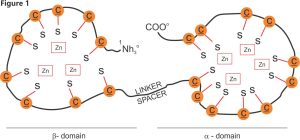We are constantly surrounded by indicators. A typical traffic light that indicates red means to stop, green means to go and so on. In Biology, Indicators are commonly used to detect the presence of a biochemical or compound. The increase or sometimes a decrease in the indicator signifies an underlying condition.
The increased levels of insulin may indicate Diabetes in humans, or for animals, increased cortisol levels indicate stress. Increase in somatic cell count indicates mastitis in cows. (Above normal levels)
Similarly, the increase in the levels of Metallothionein indicate that the Zinc concentration has reached its maximum limit in the blood. This means Zinc is highly bioavailable in the body.
What is Metallothionein?


Metallothionein is a protein present in the cells of the body. Through its structure (Figure 1), it binds to Zinc ions.
Similarly, it also helps in releasing Zinc ions back into the system. Zinc is further utilized for several enzymatic and hormonal pathways which aid in milk production and ruminant health.


Metallothionein is extremely vital for the regulation of Zinc in the body propionate and its effect on metallothionein
The following study was conducted in NDRI. A comparison between Zinc propionate, inorganic Zinc sulphate, organic Zinc compounds namely Zinc Glycinate and Zinc Methionate to assess their bioavailability and retention in dairy cows.
In the Study performed, Zinc propionate outperformed other Zinc sources in the expression of Metallothionein protein as well as increasing the expression of the gene coding for the metallothionein (MT-1)
In summary, Propionates had higher metallothionein and MT gene expression levels by
- 3% and 57% – Glycinates
- 5% and 65% – Methionates
- 6% and 83% – Sulphates, respectively
Inference and conclusion
Bioavailability and retention of trace minerals happen to be one of the main concerns of dairy farmers throughout India. Rapid dissociation of inorganic salts of Zinc in the rumen hampers its absorption and eventual utilization by the intestine. A more rational approach could be the chelation of trace minerals with ligands which resist ruminal degradation and ensure effective delivery of trace minerals in the intestine, where they are likely to be absorbed and utilized.
The role of zinc chelated with ligand Propionate has been shown to give the best results in terms of the availability of zinc for intestinal absorption.
The expression of Metallothionein gene and subsequent translation into protein is important in binding to Zinc ions. This ensures that Zinc is maintained intact in contact with the cell surface for subsequent transport, uptake and utilization by the organ systems. This would improve the Zinc-regulatory mechanisms in the body, preventing the occurrence of Zinc deficiencies, sub-optimal nutrient absorption by the body and has a better chance of countering stressful conditions which trigger free radical production.
This contrasts with inorganic salts which may rapidly dissociate leading to higher levels of mineral excretion, a consequence of sub-optimal utility and retention. Propionates performed better in terms of not only the gene expression, but also the translation to proteins, which would eventually reflect on the higher concentration and bioavailability of Zinc.
References are available upon request.
by Dr Ananth K., Kemin Industries South Asia













